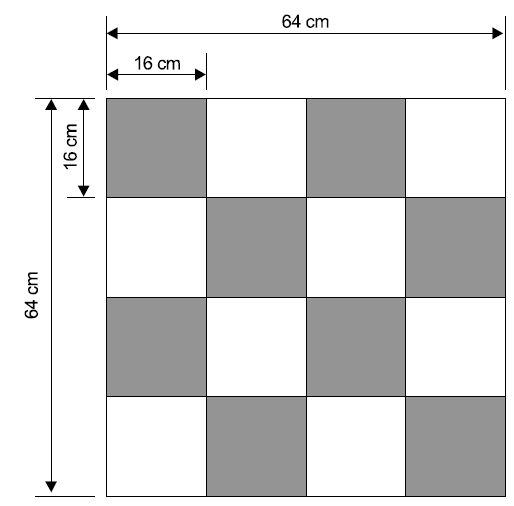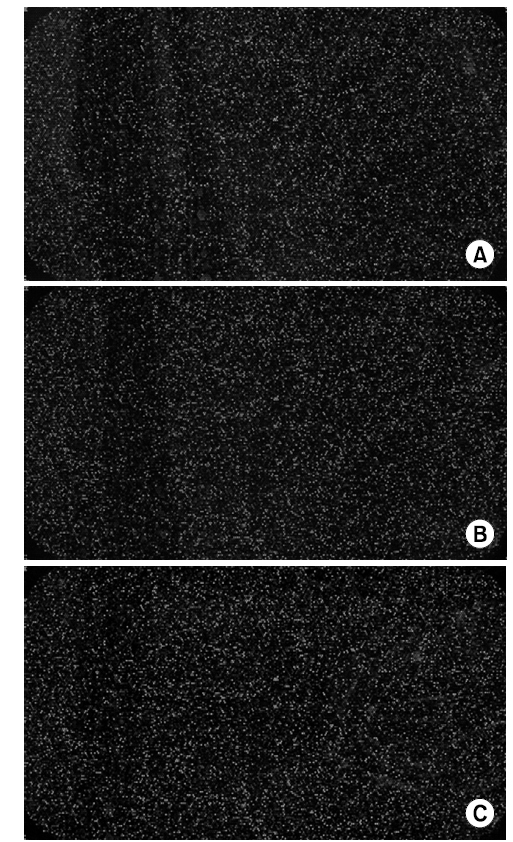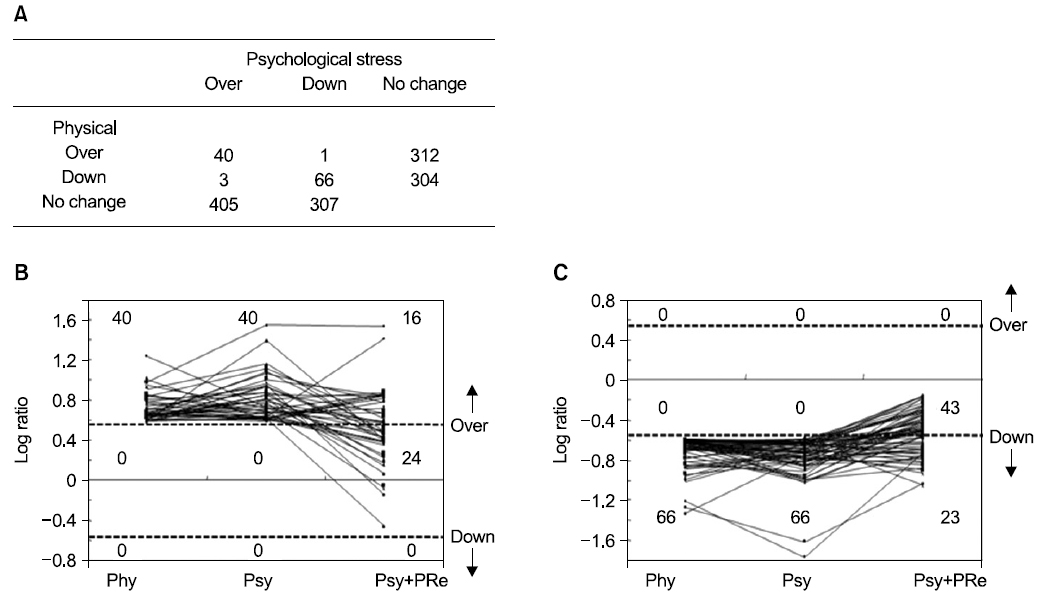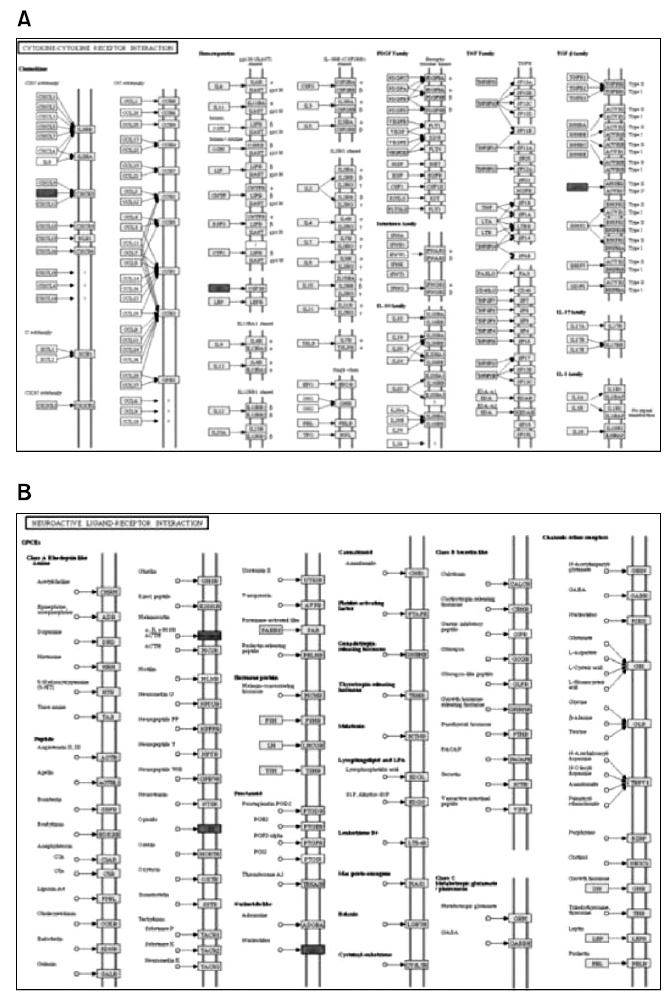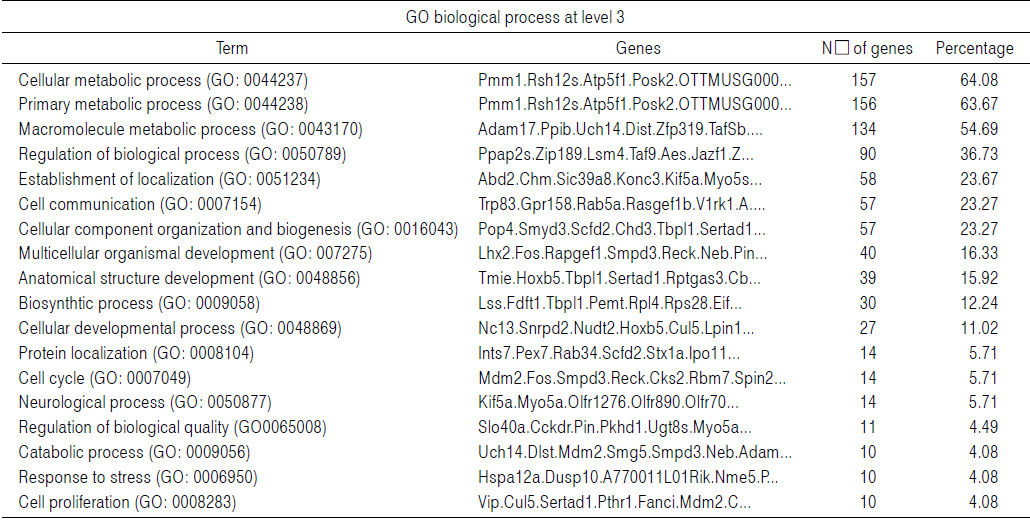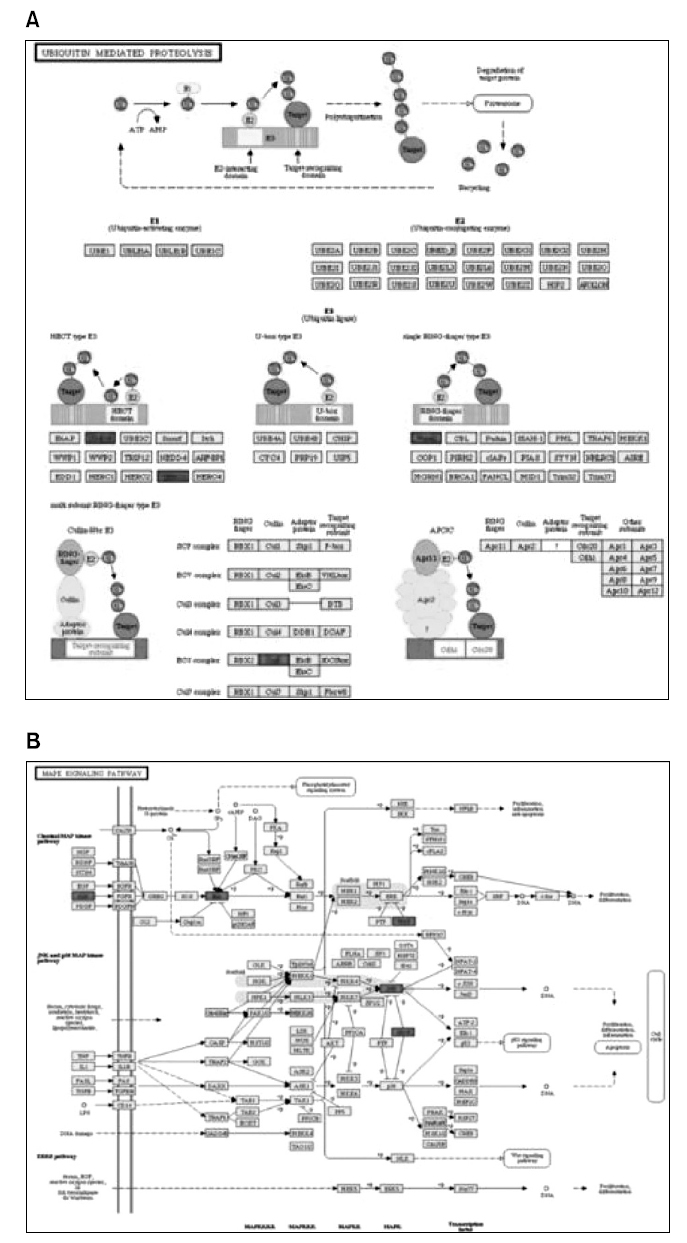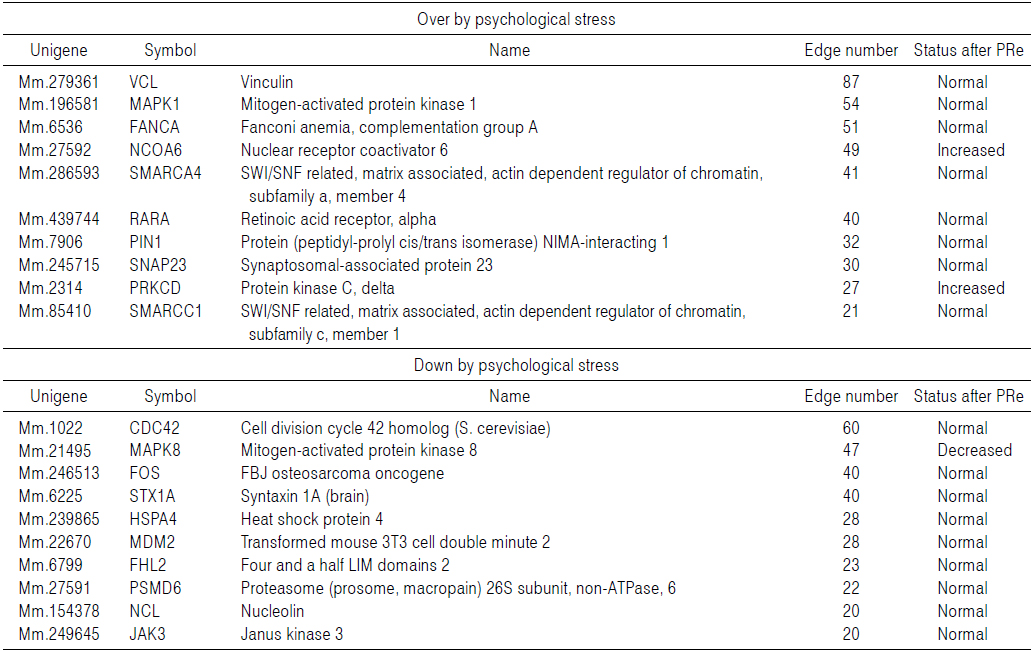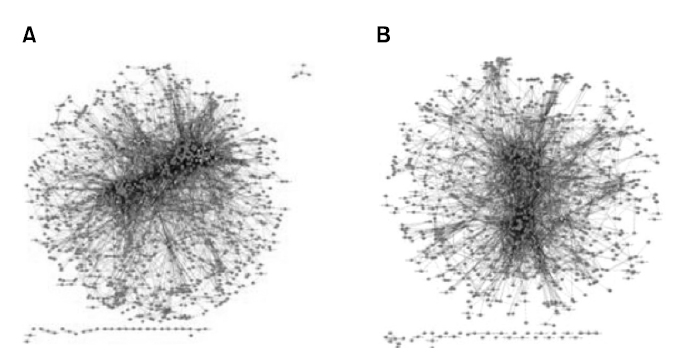



생물학적 의미로서의 스트레스란, 자극이나 변화에 대한 인체의 부적응의 상태로 교감신경계가 과활성화 되어 급성 혹은 만성적으로 신체적 또는 심리적, 행동적 문제를 초래하는 것을 말하며1), 지속적인 스트레스는 자율신경계통과 내분비 계통에 영향을 끼쳐 두통, 과민성 대장증후군, 위궤양, 당뇨병, 고혈압 뿐만 아니라 심장병, 간 경화증, 암 등 많은 질병의 발생과 밀접한 관계가 있는 것으로 밝혀져 있다2,3).
한방신경정신과에서 종종 볼 수 있는 우울, 불안 등의 질환들은 현대를 살아가는 사람들에게 있어서는 스트레스로 부터 야기되어진 것으로 보고되고 있으며4), 이러한 스트레스는 특정한 상황에 대하여 자신이 위협받는다고 받아들임으로서 야기되는 두려움, 긴장감, 우려, 근심 등의 부정적 감정으로 이해된다1).
한의학에서는 스트레스를 감정이나 외기의 변화가 하나의 자극인자로 작용하는 것에 대한 반응으로서 나타나는 현상으로 인식하고 있다5). 이들은 내부에서 기의 변조를 야기하고 질병을 일으키는 기초가 되고, 신체에 대하여 병적 요인을 제공하여 제반 질환을 야기시키는 것으로6,7) 모두 칠정(七情)의 변화에 의해 나타날 수 있는 기허, 기울, 기역 등과 관계가 있는 것으로 이해하고 있다8,9).
한의학에서는 스트레스를 기의 변화로 인식하고 한약제 투여에 따른 항스트레스 효과에 대한 연구가 활발히 진행되고 있다. 신체적 스트레스에 대해 보혈안신탕10,11), 자음건비탕12), 분심기음13), 십전대보탕14) 등의 복합 방제의 투여로부터 산조인15)과 같은 단일 약재의 투여로 인한 효과에 대한 연구 보고와 사회·심리적 스트레스에 대한 힐초근16), 호초17), 원지18), 석창포19), 반하20)등 단일 약재와 반하후박탕21)의 복합 방제 투여에 대한 연구 보고 등으로 많으나, 스트레스로 인한 뇌세포의 유전자 변화에 대한 연구는 미비한 실정이다.
연구 재료로 사용된 반하(半夏)는 거담지제(祛痰之劑)의 대표적 약물로 화담지구(化痰止嘔), 조습강역(燥濕降逆), 소비산결(消痞散結) 등의 효능으로 매핵기(梅核氣)와 흉완비민(胸脘痞悶) 등을 치료하여22) 스트레스에도 사용될 수 있는 약물이다.
본 연구에서는 마이크로어레이 분석법을 활용한 반하의 사회ㆍ심리적 스트레스에 대한 효능 평가20)에 관한 연구 방법에 준하여 스트레스를 실험 동물에 유발한 다음 적출한 뇌조직을 재료로 IMAGENE 4.0 (Bio-discovery, Marina del Rey, CA), TREEVIEW (M.B. Eisen, http://rabam.lbl. gov), FatiGo algorithms (Http://.babelomics. bioinfo. cipf.es), BOND 데이터베이스(http://bond.unleashedinformatics. com) 및 cytoscape program 등을 이용하여 유전자 변화 등을 분석하여 유전자의 종류와 작용 경로에 대한 의미있는 결과를 얻었기에 이에 보고하는 바이다.
체중 20±2 g의 ICR 계 수컷 생쥐를 대한실험동물(대한실험동물, 한국)에서 구입하여 본 대학 동물사육실에서 고형사료(삼양사료, 한국)와 물을 충분히 공급하면서 2주일 이상 실험실 환경(22℃, 12 시간 간격 조명)에 적응시킨 후 사용하였으며, 약재인 반하는 동신대학교 부속 순천 한방병원에서 사용하고 있는 제품을 구입하여 엄선한 것을 사용 하였다.
1) 반하 추출물의 조제
반하 50 g을 증류수 1,500 ml와 함께 전기 약탕기(DWP-1800T, 대웅, 한국)로 100℃에서 2시간 전탕한 후 추출액을 부직포를 이용하여 찌꺼기를 제거한 후 동결 건조기(SFDSM06, 삼원, 한국)를 이용하여 6.6 g의 건조 추출물을 얻었다. 이를 냉동실에 신선하게 보관하였다가 실험 직전에 필요한 농도로 증류수에 녹여 시료로 사용하였다.
2) 실험동물의 분류 및 약물 투여
실험동물은 신체적 스트레스군, 정상군, 대조군 및 실험군의 4개 그룹으로 나누었다. 신체적 스트레스군은 하루 1시간의 전기적 충격을 부하하였고, 정상군은 스트레스 부하장치에 노출되었으나 신체적 심리적 스트레스에 노출되지 않고 아무 처치도 안하였으며, 대조군은 신체적 스트레스군을 옆에서 지켜보는 것으로써 사회ㆍ심리적 스트레스를 부하하면서 증류수를 투여하였고, 실험군은 사회ㆍ심리적 스트레스를 부하하면서 반하 추출물을 100 mg/kg로 투여하였다. 투여 시기와 방법은 각각 1일 1회 5일간 스트레스 부하 30분 전에 경구 투여하였다.
3) 스트레스 부하 장치 및 실험
스트레스 부하 실험은 Ogawa 등23)이 개발한 것을 Shibasaki 등24)이 보완하여 개발한 사회ㆍ심리적 스트레스부하 장치를 사용하였다. 동물 실험을 통해서도 사람의 일상적인 사회ㆍ심리적 스트레스를 대신할 수 있도록 고안ㆍ제작된 communication box를 사용하여 ICR 계 생쥐를 실험동물로 하여 사회ㆍ심리적 스트레스 상태를 유발한 다음 반하 추출물을 실험군에 투여하여 스트레스의 해소에 어느정도 영향을 미치는가를 평가하였다.
사회ㆍ심리적 스트레스 부하 장치는 Fig. 1과 같이 크기가 64×64×40 cm3로서 16개의 작은 방(16×16 cm2)으로 되어 있고, 그 중에서 어둡게 표시된 8개의 방바닥에 1.3 cm 간격으로 직경 0.5 cm 굵기의 동선을 깔고 foot shock으로 전기적 충격을 부하할 수 있도록 전기 장치에 연결되도록 설계되어 있다. 이들 16개의 방 사이에는 투명한 플라스틱으로 설치하여 foot shock에 의한 전기적 충격을 방지할수 있도록 설치했다. 전기적 foot shock은 2.0 mA의 전류를 10초 동안 진행되며 120초 간격으로 다시 foot shock이 부하되도록 제작되었다. 매일 오전 10시부터 신체적 스트레스군에 1시간의 foot shock을 5일간 부하하였다.
4) Microarray 데이터 분석
ICR 마우스의 전뇌를 이용하여 반하의 사회ㆍ심리적 스트레스에 대한 효능 평가20)를 수행한 이전 연구자로부터 제공받은 Microarray 원본 이미지파일에서 IMAGENE 4.0(Bio-discovery, Marina del Rey, CA)을 사용하여 1차 데이터를 얻은 후 lowess method (Zahurak M, 2007)를 사용하여 표준화하였다. 모든 칩상의 spot에서, 각 채널의 형광 강도가 배경의 형광 강도보다 1.4배 더 큰 경우에 한해 제대로 측정된 것으로 판단하여 선별하였고, 시료에서 제대로 측정되지 않은 것은 제외시켰다. 발현 비율은 CLUSTER를 이용하여 순차적 클러스터링한 후 TREEVIEW (M.B. Eisen, http://rabam.lbl.gov)25)를 이용하여 시각화하였다. 유전자 기능분석은 FatiGo algorithms (Http://.babelomics. bioinfo.cipf.es)를 이용하여 수행하였다. 클래스간 비교분석을 통해 얻어진 결과는 False Discovery Rate (FDR) 값이 0.05 이하일 때 의미있는 것으로 판단하였다. 단백질 결합은 BOND 데이터베이스(http://bond.unleashedinformatics. com)에서 얻어진 단백질 데이터베이스로 cytoscape program을 이용하여 분석하였다.
1. Microarray 이미지 및 유전자 발현 프로파일
Microarray 분석을 통한 이미지는 Fig. 2과 같으며, 이를 바탕으로 발현 변화를 보이는 유전자를 선택하여 클러스터링 하였다(Fig. 3). 대부분의 유전자들은 스트레스군과 실험군에서도 유사한 발현 패턴을 보였으나 일부의 유전자는 서로 다른 발현 패턴을 나타냈다. 이러한 유전자 발현 패턴을 크게 2가지의 군으로 분류 하였다(Fig. 3). 즉, (A) 스트레스 대조군에서 발현이 증가하였으나 실험군에서 변하지 않은 유전자, (B) 대조군에서 발현이 감소하였으나 실험군에서는 변하지 않은 유전자로 분류하였다. 전체 유전자 발현 프로파일에서 각 패턴의 위치는 Fig. 3에 표시되어 있다.
Fig. 4은 스트레스 대조군에서 발현이 일괄적으로 증가 혹은 감소된 유전자들이 실험군에서는 어떠한 양상을 보였는지를 나타낸다. 신체적 스트레스와 심리적 스트레스에 의한 유전자 발현이 각기 다른 양상을 보였는데(Fig. 4A) 이는 각각의 스트레스에 따라 변화하는 유전자가 다름을 의미한다. 따라서 본 연구에서는 두 스트레스 대조군에서 동일한 발현 양상을 보인 유전자들을 구분하여 분석하여 보았다(Fig. 4B, C). 그 결과 40개의 유전자들이 스트레스 대조군에서 모두 발현이 증가하였으며, 이 중 60%에 해당하는 24개의 유전자가 반하 추출물 투여로 정상 수준을 유지하였으며, 66개의 유전자가 스트레스 대조군에서 모두 발현이 감소하였는데, 이 중 65%에 해당하는 43개의 유전자가 역시 반하 추출물 투여에 의해 정상 수준을 유지하였다.
2. 발현의 증가가 억제된 유전자들의 생물학적 과정, 분자기능 및 세포 구성요소 구분에 따른 분포
심리적 스트레스군에서는 발현이 증가하였으나 심리적 스트레스와 함께 반하 추출물을 투여한 실험군에서는 발현이 정상 상태를 유지한 경우에서의 유전자 기능분포를 생물학적 과정, 분자기능 및 세포 구성요소로 나누어 분석하였다. 생물학적 과정항목에서는 cellular metabolic process, primary metabolic process 및 macromolecule metabolic process 등과 관련한 유전자가 많았다(Table 1A). 분자 기능항목에서는 protein binding, ion binding 및 nucleic acid binding 등과 관련한 유전자가 많았다(Table 1B). 세포 구성요소 관련 분석에서는 cell part, membrane-bound organelle 및 organelle part에 관련한 유전자가 많았다(Table 1C).
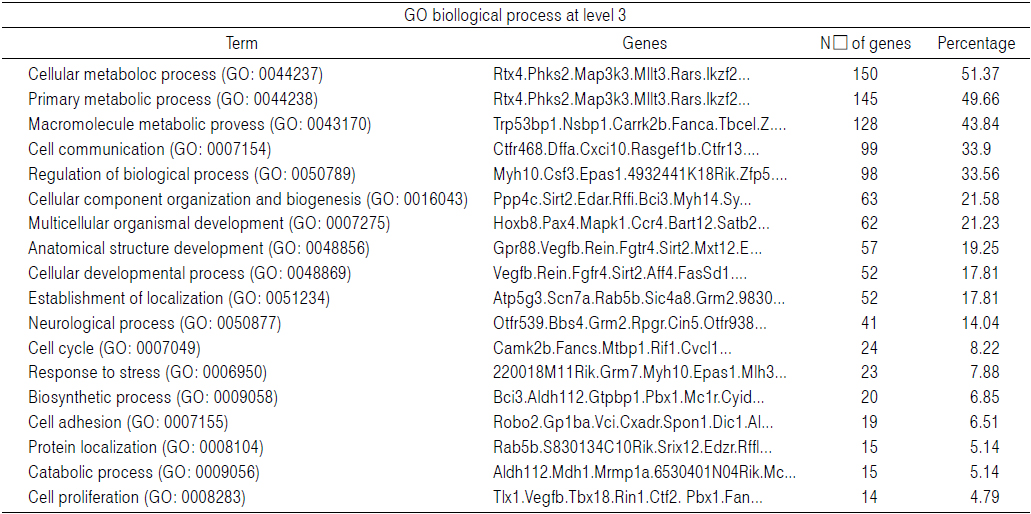
Functional Annotation of Genes Related in Biological Process. The Horizontal Bar Represents the Percentage of Specific Functional Category in Biological Process, The List was Arrayed in Decreasing Percentage of Functional Category
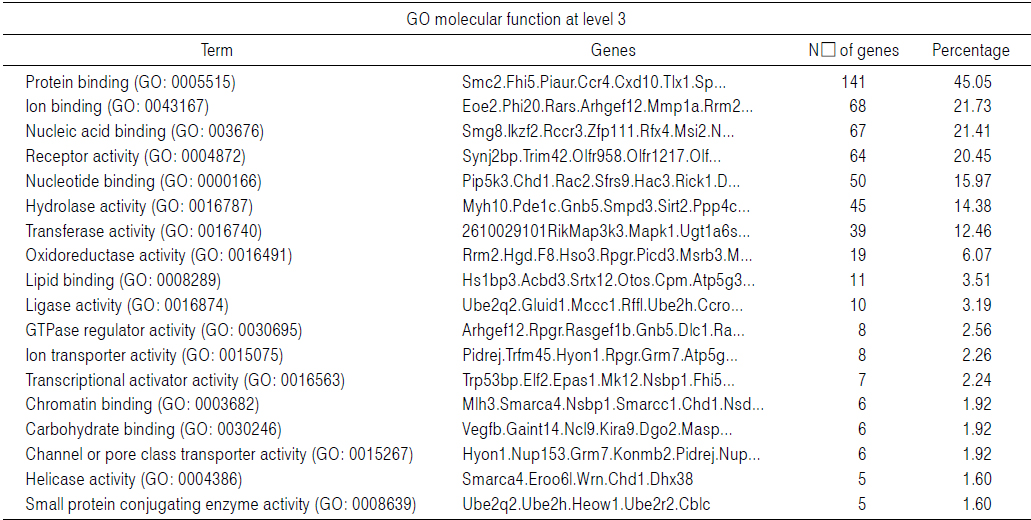
Functional Annotation of Genes Related in Molecular Function. The Horizontal Bar Represents the Percentage of Specific Functional Category in Molecular Function, The List was Arrayed in Decreasing Percentage of Functional Category
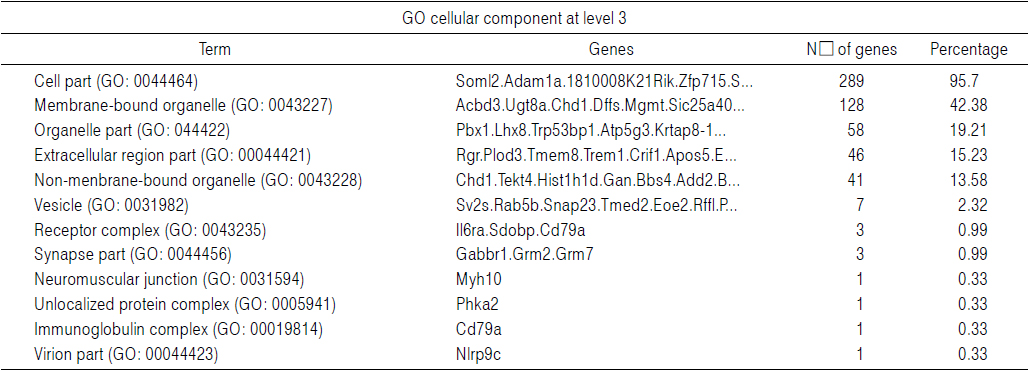
Functional Annotation of Genes Related in Cellular Component. The Horizontal Bar Represents the Percentage of Specific Functional Category in Cellular Component, The List was Arrayed in Decreasing Percentage of Functional Category
3. 발현의 감소가 억제된 유전자들의 pathway 분석
심리적 스트레스 대조군에서 발현이 감소하였으나 반하 추출물 투여에 의해 정상수준으로 발현이 복귀된 유전자들이 관련되어 있는 pathway를 분석한 결과, cytokine-cytokine receptor interaction 및 neuroactive ligand-receptor interaction 항목 등이 있음을 확인하였다(Table 2). Fig. 5는 pathway의 자세한 경로와 관련 유전자를 나타낸 모식도이며, 붉은 색으로 표시된 부분에 해당하는 유전자에 반하 추출물이 작용했음을 나타낸다.
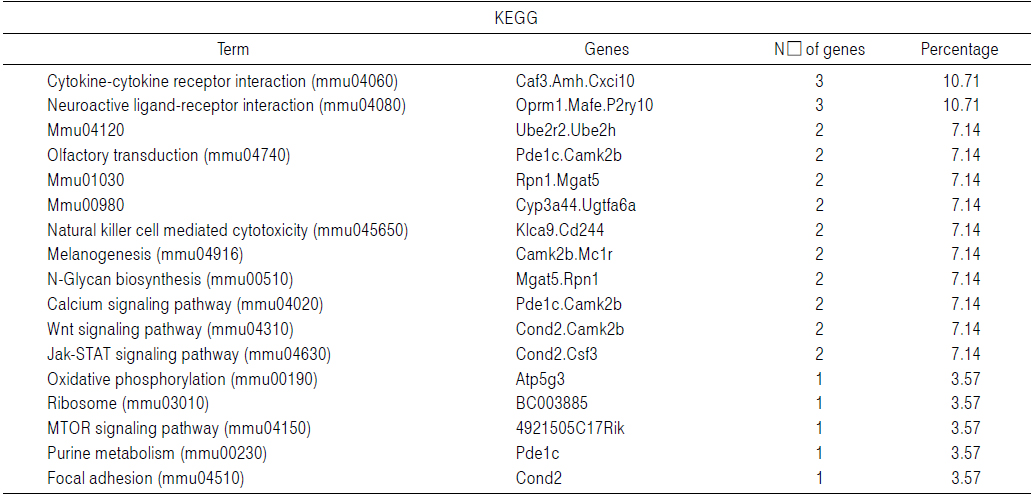
Pathway Analysis of Restored Genes from up-regulation by Psychological Stress. Pathway Analysis between Class A Genes in Animals Treated with PRe. Involvement of These Genes on Different Pathway was Analyzed (A). The Horizontal Bar Represents the Percentage of Genes on each Pathway. The List was Arrayed in Decreasing Percentage of Pathway Involvement. Sample Pathways (B and C) were Showed in Detail in which the Class A Genes were Colored in Red. The Represented Pathways were Obtained from KEGG
4. 발현의 감소가 억제된 유전자들의 생물학적 과정, 분자기능 항목에 따른 분포
심리적 스트레스군에서는 발현이 감소하였으나 심리적 스트레스와 함께 반하 추출물을 투여한 실험군에서는 발현이 정상 상태를 유지한 경우에서의 유전자 기능분포를 생물학적 과정, 분자기능으로 나누어 분석하였다. 생물학적 과정 항목에서는 cellular metabolic process, primary metabolic process 및 macromolecule metabolic process 등과 관련한 유전자가 많았다 (Table 3A). 분자기능항목에서는 coupled ATPase activity, MAP kinase activity 및 MAP kinase phosphatase activity 등과 관련한 유전자가 많았다(Table 3B).

Functional Annotation of Genes Related in Biological Process. The Horizontal Bar Represents the Percentage of Specific Functional Category in Biological Process, The List was Arrayed in Decreasing Percentage of Functional Category
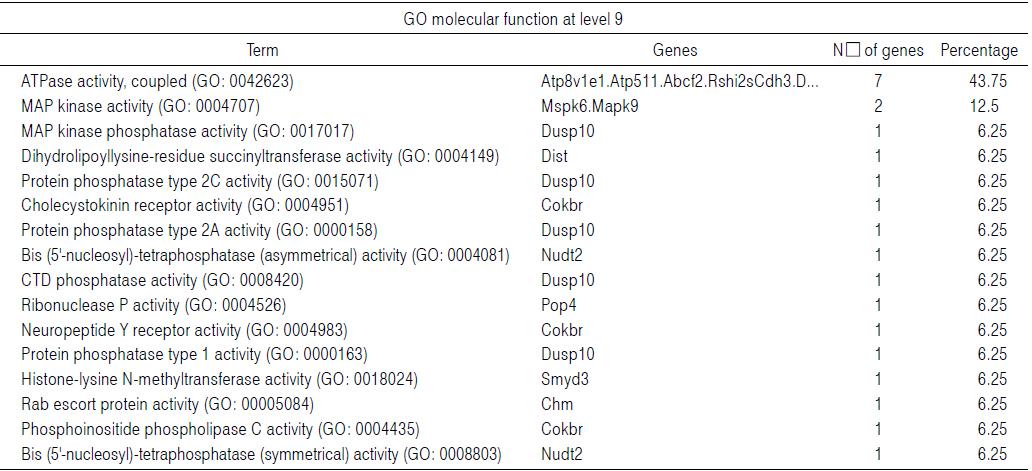
Functional Annotation of Genes Related in Molecular Function. The Horizontal Bar Represents the Percentage of Specific Functional Category in Molecular Function, The List was Arrayed in Decreasing Percentage of Functional Category
5. 발현의 감소가 억제된 유전자들의 pathway 분석
심리적 스트레스 대조군에서 발현이 감소하였으나 반하 추출물 투여에 의해 정상수준으로 발현이 복귀된 유전자들이 관련되어 있는 pathway를 분석한 결과, Ubiquitin mediated proteolysis (mmu04120) 및 MAP kinase signaling pathway 등이 있음을 확인하였다(Table 4). Fig. 6은 pathway의 자세한 경로와 관련 유전자를 나타낸 모식도이다.
[Table 4.] Pathway Analysis of Restored Genes from Down-regulation by Psychological Stress
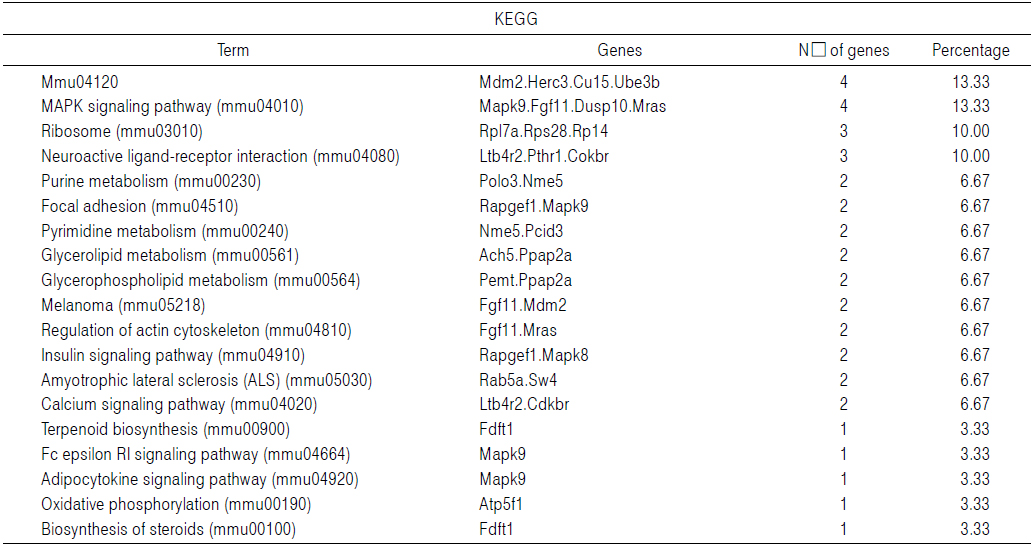
Pathway Analysis of Restored Genes from Down-regulation by Psychological Stress
심리적 스트레스에 의해 변화하는 유전자들의 상호작용을 분석하기 위해 단백질 상호 작용 네트워크로 분석한 결과 약 1,336종의 유전자들의 발현이 증가되었고, 1,053종의 유전자들의 발현이 감소되었다(Table 5). Fig. 7에서 노란색을 띄는 부분은 심리적 스트레스에 의해 변화되는 유전자 중 상호작용에서 중심 역할을 하는 유전자에 해당된다.

Top 10 Core Node Genes Altered by Psychological Stress. Genes were Ordered according to the Number of Interaction Edges. The Expression Level of each Gene Following Treatment with PRe is also Shown
스트레스란 외부의 위협에 대한 인체의 반응, 자아위협에 대한 반응, 환경적 요구와 유기체의 반응능력간의 불균형, 그리고 자원의 위협이나 손실 등을 야기시킬 수 있는 위험인자로 설명되어지며, 외부로부터의 위협이 반응능력의 수준을 넘어서거나 혹은 일정하게 유지하고 있는 각 개인들의 자원에 위협을 가하게 됨으로써 발생하게 되는 심리적이면서도 또한 상황적 맥락에 의해 영향을 받는 인간의 갈등상태를 표현해주는 개념으로 정의된다26). 생물학적 스트레스란 자극이나 변화에 대한 인체의 부적응 상태로 교감신경이 과활성되어 급성 또는 만성적으로 신체적, 심리적 또는 행동적 문제를 야기하게 되는 것을 말한다1).
스트레스가 누적되면 심리적으로 예민해져 걱정과 불안, 초조, 긴장 등으로 인한 신경쇠약과 우울, 의욕 상실 등의 증상이 나타나고 심한 경우에는 자살에 이르기도 하며, 만성적 스트레스는 생리적으로 자율신경계와 내분비계에 영향을 미쳐 두통, 과민성대장증후군, 위궤양, 당뇨병, 고혈압, 심장병, 간경화증, 암 등 많은 질병의 발생과 밀접한 관련이 있는 것으로 보고되고 있다26-28). 행동적인 측면에서도 스트레스를 과도하게 느끼게 되면 대인관계에서 말씨가 거칠어지고 공격적인 행동을 취하게 되는 등 여러 병적인 현상들이 나타나게 된다29).
각종 스트레스는 동물의 신경과 호르몬 분비를 자극하여 심장을 비롯한 각종 장기에 형태학적 및 기능적 변화를 일으킨다는 것은 잘 알려진 사실이며30-36), 신체적 활동을 제한하는 부동스트레스도 심장근육의 부분적인 출혈과, 미세괴사를 일으키는 등 실험동물에게 치명적인 영향을 미칠 뿐만 아니라37), 심방근육세포, 사립체능선의 파괴, 근육원섬유의 융해, 분비과립의 분포 변화와 심방근육세포의 세포자멸사를 일으키는것으로 밝혀지는 등38), 다양한 스트레스가 신체의 생리적 기능에 장애를 초래한다는 연구 결과들이 다수 보고되어 있다. 또, 실험적으로 저산소증을 유발할 경우 심장근육세포의 근육세포질세망과 근육형질막이 부분적으로 파괴되며, 세포막의 투과성을 세포뼈대단백질인 vinculin과
하지만 보건의료 분야에서의 대다수 연구들은 정신적 장애 보다 신체적 장애에 비중을 두어 상대적으로 많은 진전을 보여 왔기 때문에 정신건강이나 심리학적 증상에 대한 현황 조사가 미흡한 상태이며26) 한의계에서도 임상에서 다양한 환자를 접할 수 있기는 하지만 상태를 개선시키는 것으로 알려진 처방들의 자세한 기전은 아직 연구되지 못하고 있다.
서양의학 및 심리학과 한의학은 배경철학이나 기본이론, 질병관, 치료법 등 많은 부분에서 큰 차이가 있으며, 스트레스란 단어는 서양에서 사용되어진 용어이므로 오랜 기간 동안 임상의학으로 발전해온 한의학에서 스트레스와 정확히 대비되는 단어는 찾기 어렵다. 다만 자연계의 변화가 직접적 혹은 간접적으로 인체의 생리와 병리에 상응하는 변화를 일으킨다는 의미의 천인상응론(天人相應論), 생명체의 각 부분의 활동은 언제나 개체 전체로서의 관계와 상관된다고 전제하는 정체개념(整體槪念) 등이 스트레스를 한의학적으로 이해하는 전제에 해당된다고 볼 수 있다40,41).
한의학에서는 정신적 스트레스는 칠정소상(七情所傷)에 의한 기울과 기체반응(氣滯反應)과 연관하여, 생리적 스트레스는 육음사로 인한 외감이나 외상에 의한 인체반응과 연관하여 인식하였다42).
『내경(內經)』을 비롯한 역대 문헌에서 정신적 스트레스와 유관한 부분을 찾아보면 칠정상이 오장의 허실 혈허 정손 기허 기의 순행장애 담연의 조성 등의 병적인 요인을 만들며 육체적인 과로나 음식부절, 과음과식 등도 또한 결과적으로 정신작용에까지 영향을 미친다고 보았다. 또한 감정의 변화에 대한 생체의 반응을 기의 변화로 설명할 수 있는데,『소문ㆍ거통론(素問ㆍ擧痛論)』43)에 노하면 기상하고, 희하면 기완하며, 비하면 기소하고, 공하면 기하하고, 경하면 기란하며 사하면 기결한다고 하여, 칠정의 편승이 기기승강에 영향을 미쳐서 곧 질병을 일으킬 수 있음을 말하였다. 이를 역대 문헌에서는 칠기(또는 구기) 기울 중기 기통기역 등으로 서술하였고8,9,44), 한의학에서는 이들에 의한 신체반응을 기의 변화로 인식하고 있다.
또, 생리적 스트레스와 유관한 부분을 찾아보면 『영추ㆍ구문편(靈樞ㆍ口問篇)』43)에서 “부백병지시생야, 개생어풍우한랭, 음양희노, 음식기거, 대경졸공칙 기혈분리(夫百病之始生也, 皆生於風雨寒冷, 陰陽喜怒, 飮食起居, 大驚卒恐則氣血分離)”라 하여 스트레스 인자로 기후, 정동, 음식, 기거등을 제시하였고, 송대의 진(陳)은 『삼인방(三因方)』45)에서 질병발생의 인자로서 육음사기의 침습을 외인과 음식노권, 질부금도(跌仆金刀) 및 충수(虫獸)에 상한 것 등을 불내외인 등으로 인식하고 있음을 알 수 있다.
따라서 한의학에서는 감정이나 외기의 변화가 하나의 자극인자로 작용하는 것을 스트레스라 인식하였고, 칠정상에 의해 발생하는 기의 변조를 사회ㆍ심리적 스트레스라고 인식하였다. 또, 이러한 자극요인들이 신체에 정기와 사기의 상호관계에 영향을 미치게 되고 그 결과 병적 요인이 발생하여 제반질환이 발생한다고 보았다46).
이처럼 외부로부터의 반복적인 자극으로 인해 생명 조절계에 이상이든지, 기의 변화에 의한 것이든지 결과적으로 스트레스로 인한 질병 발생 측면에서는 서양의학과 한의학 모두 유사한 기록을 보이고 있다. 또한 스트레스 자극과 반응에 관한 보고들에 관한 연구들도 확인할 수 있는데, 자극으로서는 내인, 외인, 불내외인을 말하였고, 스트레스에 대한 인체의 반응은 정기와 사기의 상호작용으로 설명하고 있다45,47,48).
한의학계에서의 스트레스 관리법은 많은데, 대체적 내용을 정리하면 자연에의순응, 정신 수양, 정서의 조절, 기공요법, 체질에 맞는 생활, 음식과 성생활의조절, 한방정신요법, 약물치료 등으로 귀결되며40), 이러한 관리법들의 효용성에 관한 구체적인 연구는 많이 부족한 실정이다.
스트레스를 기의 변화로 인식하고 한의학적인 관점에서 항스트레스 효과에 대한 연구가 활발히 진행되고 있다. 신체적 스트레스에 대해 복합 방제인 보혈안신탕10,11), 자음건 비탕12)을 투여하여 뇨나 혈중의 catecholamine 함량측정이나 분심기음13), 십전대보탕14)을 투여하여 혈청 cortisol 함량을 지표로 한 것들에서 효과가 있다는 보고와 단일 약재인 산조인15)을 투여하여 혈청 중 corticosterone 함량이나 뇌 조직 내 noradrenaline 등의 함량을 측정한 보고가 있으나, 사회ㆍ심리적 스트레스에 대한 보고는 힐초근16), 호초17), 원지18), 석창포19), 반하20) 등의 단일 약재와 반하후 박탕21)의 복합 방제 투여에 따른 혈청 중 코티코스테론의 함량, 뇌조직내 노르아드레날린의 함량, 혈청 내 지질 과산 화물 함량과 항불안 효과에 대한 연구 보고가 있다.
이전 연구자 김의 연구 결과20), 반하 추출물 투여로 인해 뇌의 dorsal cortex 부분의 노르아드레날린 함량은 유의하게 증가하였고, elevated plus-maze에서 open arm에 머무는 시간이 실험군에서 대조군에 비해 유의하게 증가하는 등 반하 추출물이 스트레스를 효과적으로 해소시킬 뿐만 아니라 스트레스로 인한 생체의 각종 질병발생 억제에도 작용할 수 있는 가능성을 보고하였으며, microarray를 이용하여 초보적인 해석을 하였으므로, 본 연구에서는 microarray 결과를 입수 한 후 진보된 분석법을 이용하여 변화된 유전자들의 프로파일을 분석함으로써 미약하게나마 반하 추출물이 스트레스 해소에 관여한 근거를 찾고자 하였다.
연구에 사용된 재료인 반하(Pinelliae Rhizoma)는 천남성과(천남성과: Araceae)에 속한 다년생초본인 끼무릇 (Pinellia ternata (Thunb.) Breitenbach)의 코르크층을 제거한 덩이줄기로, 성은 온하고 미는 신하며 비ㆍ위ㆍ폐로 귀경하고, 화담지구ㆍ조습강역ㆍ소비산결 등의 효능이 있어 담다천해ㆍ담음현훈ㆍ풍담현훈ㆍ담궐두통ㆍ구토반위ㆍ흉완비민ㆍ매핵기증 등을 치료하며22), 임상적으로는 거담의 목적으로 매핵기 및 두통, 현훈 등의 다양한 신경성 질환에 많이 응용되고 있다. 이 중 매핵기나 흉완비민 등의 증상이 스트레스로 인한 증상과 유사하여 항스트레스 효과에 관한 실험에 사용되고 있다.
반하에 관한 연구들로는 비만49), 임신 중 입덧50), 천식51)등 에 관한 연구들이 있었을 뿐, 심리적 스트레스에 관한 실험연구는 아직 미흡하였다.
김의 연구 결과20) 중 반하 추출물 투여로 인해 사회ㆍ심리적 스트레스와 관련된 유전자들의 분포에 변화가 있지만 정상수준으로 회복시키는 수준은 아닌 것으로 판단하였으나 구체적인 유전자들의 경로 등에 관한 연구까지는 진행되지 않았으므로 본 연구에서는 유전자 프로파일 중심으로 관찰하였다.
변화가 확인된 유전자들을 선택하여 클러스터링 한 결과(Fig. 3), 대부분의 유전자들은 스트레스군과 실험군에서도 유사한 발현 패턴을 보였는데, 이러한 결과는 스트레스에 의한 유전자의 변화는 크지 않다는 것을 보여주는 결과이므로 이후에는 半夏 추출물 투여에 의해 변화가 관찰된 일부 유전자들을 대상으로 발현 패턴을 크게 2가지의 군으로 분류 하였다. 하나는 스트레스 대조군에서 발현이 증가하였으나 실험군에서 변하지 않은 유전자, 또 다른 하나는 대조군에서 발현이 감소하였으나 실험군에서는 변하지 않은 유전자로 분류하여 전체 유전자 발현 프로파일에서 각 패턴의 위치는 Fig. 3에서 A 및 B로 표시하였다. 즉 스트레스로 인해 발현이 변화되었으나 반하 추출물을 투여하였을 경우에는 변화가 없었던 유전자들의 구획을 표시한 것이다.
본 연구의 주제는 심리적 스트레스로 제한하였으나 연구방법에서 신체적 스트레스를 부하한 대조군을 관찰하는 것으로 심리적 스트레스를 유발하였으므로 스트레스 대조군에서 일괄적으로 변화가 관찰된 유전자를 분류하였으며 심리적 스트레스가 부하된 실험군에서 어느 정도 유전자 발현 변화를 억제할 것인지를 관찰하였는데(Fig. 4), 스트레스 대조군에서 발현이 증가된 40개의 유전자 중 60%에 해당하는 24개의 유전자가 반하 추출물 투여로 정상 수준을 유지하였으며, 스트레스 대조군에서 발현이 감소된 66개의 유전자 중 65%에 해당하는 43개의 유전자에서 반하 추출물 투여로 정상 수준을 유지하는 결과를 보였다(Fig. 4B, C). 이러한 결과는 스트레스의 종류가 신체적이건 심리적이건 동일한 유전자에 변화를 가져올 수 있으며 이러한 유전자의 변화 중 상당수에 대해 반하 추출물이 효과적으로 작용하였음을 보여주는 것으로 김의 연구 결과12)에서 제시하지 못한 구체적 유전자의 회복 기능을 확인한 결과로 생각된다.
이후의 연구 결과들은 심리적 스트레스에 의해 발현이 변화되었으나 半夏 추출물 투여에 의해 정상 수준을 유지한 유전자들이 주로 관여하는 기능에 관한 관찰 결과이다(Tables 1-4). 심리적 스트레스 대조군에 의해 발현이 증가 되었으나 실험군에서 발현의 증가가 억제된 유전자들의 경우 생물학적 과정항목에서는 cellular metabolic process, primary metabolic process 및 macromolecule metabolic process 등과 관련한 유전자가, 분자기능항목에서는 protein binding, ion binding 및 nucleic acid binding 등과 관련한 유전자가, 세포 구성요소 관련 분석에서는 cell part, membrane-bound organelle 및 organelle part에 관련한 유전자가 많았는데, 이러한 유전자들의 작용 기전을 분석한 결과 cytokine-cytokine receptor interaction 및 neuroactive ligand-receptor interaction 항목 등이 있었다. 또한 심리적 스트레스 대조군에서는 발현이 감소하였으나 실험군에서 발현이 정상 상태를 유지한 경우에서의 유전자 기능분포는 생물학적 과정 항목에서는 cellular metabolic process, primary metabolic process 및 macromolecule metabolic process 등과 관련한 유전자가, 분자기능항목에서는 coupled ATPase activity, MAP kinase activity 및 MAP kinase phosphatase activity 등과 관련한 유전자가 많았다. 이러한 유전자들이 pathway를 분석한 결과, Ubiquitin mediated proteolysis (mmu04120) 및 MAP kinase signaling pathway 등이 있음이 확인되었다. 따라서 본 연구를 통해 심리적 스트레스에 의한 유전자의 변화 중 半夏 추출물이 어떠한 과정에 작용하는지와 구체적 작용 기전 및 위치를 확인할 수 있었다.
이상의 분석 결과만으로는 발현 변화가 억제된 유전자들의 상호 작용과 중요도에 관한 정보를 확인할 수 없으므로 이를 분석하기 위해 단백질 상호 작용 네트워크로 분석하였으며, 그 결과 약 1,336종의 유전자 발현의 증가와 1,053종의 유전자 발현의 감소를 확인하였으며(Fig. 7), 이를 바탕으로 핵심 역할을 하는 유전자 각 10종을 선별하여 보았다(Table 5). 이 중 심리적 스트레스 대조군에서 증가하였다가 실험군에서 증가가 억제된 대표적 유전자인 vinculin은 포유류의 세포에서 세포막의 골격을 유지하는데 관여하며 역시 유사한 작용을 하는
위의 결과로는 반하 추출물 투여가 뇌조직에서의 유전자에 어떠한 영향을 미치는지 정확하게 확인할 수는 없지만 심리적 스트레스에 의해 세포의 골격 유지와 세포 주기의 조절에 있어서 중요한 역할을 하는 유전자들에 변화가 관찰되며, 반하 추출물 투여가 이러한 변화를 억제함으로써 스트레스로 인한 여러 증상을 개선할 수 있는 것으로 추정된다.
반하 추출물이 심리적 스트레스에 의한 유전자 변화를 관찰하기 위하여 심리적 스트레스를 부하하면서 반하 추출물을 100 mg/kg로 5일간 투여한 후 뇌조직을 적출한 후 microarray 분석법을 이용하여 관찰한 유전자 변화를 IMAGENE 4.0, TREEVIEW, FatiGo algorithms, BOND 데이터베이스 및 cytoscape program 등을 이용하여 분석한 결과 다음과 같은 결론을 얻었다.
1. 신체적 스트레스군와 사회ㆍ심리적 스트레스군 모두에서 발현이 증가한 유전자 중의 60%와, 발현이 감소한 유전자 중 65%의 유전자가 반하 추출물 투여에 의해 정상 수준을 유지하였다.
2. 대조군에서는 발현이 증가하였으나 반하 추출물을 투여한 실험군에서 발현이 정상 상태를 유지한 경우, 생물학적 과정 항목에서는 cellular metabolic process 등이, 분자기능 항목에서는 protein binding 등이, 세포 구성요소 항목에서는 cell part 등에 관련한 유전자가 많이 속해 있었으며, 이러한 유전자가 관여한 pathway에는 cytokine-cytokine receptor interaction 등이 있었다.
3. 대조군에서는 발현이 감소하였으나 반하 추출물을 투여한 실험군에서 발현이 정상 상태를 유지한 경우, 생물학적 과정항목에서는 cellular metabolic process 등이, 분자기능항목에서는 coupled ATPase activity 등에 관련한 유전자가 많이 속해 있었으며, 이러한 유전자가 관여한 pathway에는 Ubiquitin mediated proteolysis 등이 있었다.
4. 단백질 상호 작용 네트워크로 분석한 중심 유전자들에는 Vinculin 및 Cell division cycle 42 homolog (S. cerevisiae)등이 있었으며 이러한 유전자들은 세포의 골격 유지와 세포 주기의 조절에 있어서 중요한 역할을 하는 유전자에 속한다.
이상의 내용으로 미루어 반하 추출물이 스트레스를 해소하는 과정에서 관여하는 구체적인 신호 전달 경로와 유전자들을 확인할 수 있었다.
